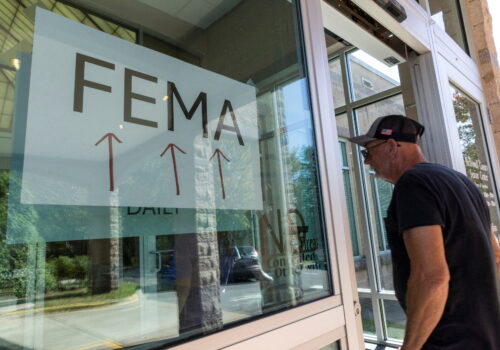From the World Cup to the Olympics, the US must put security and resilience first
Americans are entering a decade in which they will be front and center in international sports. In 2026, the United States, along with Canada and Mexico, will host the World Cup. In 2028, Los Angeles will host the Summer Olympics. Then in 2034, Salt Lake City will host the Winter Olympics. While it’s exciting for US cities to host these global events, doing so also poses complex security challenges requiring years of planning and coordination.
Securing large-scale sporting events has only become more complex in recent years. In recent research, I put forth a framework that clarifies the security challenges sporting events face by organizing the most pressing threats into five categories. These five categories encompass threats in the digital and physical realms. They also include threats to athletes, fans, venues, and the very integrity of sport itself. The five categories are:
Targeted harassment or violence includes fans, bettors, or others directly threatening athletes to affect their performance or because of their performance.
Direct integrity threats include actions that threaten the integrity of the game, such as point shaving, match fixing, or athletes augmenting their performance to suit gambling or other purposes outside of fair play.
Artificial intelligence (AI)–enabled threats are increasingly prevalent, as AI lowers the barrier for non-technically inclined individuals to exploit digital and physical tools for malicious purposes.
Data security threats also are a concern, as bettors share personal information with sportsbooks for Know Your Customer and anti-money laundering regulations. Teams, leagues, integrity monitors, and data clearinghouses maintain vast troves of information about their products and their customers. Criminals, nation-states, and others continue to target that data.
Foreign interference should also be anticipated, as the playbook exists for foreign adversaries to use social media, AI, and other technology to sow doubt and discord in civic life. That playbook is available for those same adversaries to sow doubt and discord about the fairness or integrity of sport, particularly with the rise in gambling.
While the categories overlap in places, this framework creates a structure for security experts and policymakers to better understand what vulnerabilities exist—and how to build resilience in the face of those threats. Perhaps most importantly, these categories represent dangers that need to be addressed well before the athletes assemble and the matches or races start.
These threats are not just theoretical. The framework above roughly encapsulates the attacks that have been carried out around major sporting events worldwide in the past decade or so. This includes attacks surrounding the 2024 Paris Summer Olympics, the vicinity of the 2025 College Football Playoff Championship, the 2018 World Cup in Russia, the 2018 Winter Olympics in South Korea, and even the 2024 Cricket World Cup, which was held in the United States.
Americans often take for granted the space that sports occupy in their lives. Whether it’s watching a favorite pro or college team, or kids playing sports as they grow up, these games are part of the American civic fabric. When participants or spectators are attacked—or when the integrity of sport itself is questioned—another thread of US society is severed. While securing high profile events is certainly an important task, installing defensive and reactive measures alone is not sufficient. More proactive, coordinated action is needed.
Three elements of proactive security
To move beyond reactive strategies, event organizers and policymakers must prioritize three key elements of proactive security: transparency, communication, and technology.
Each area is important to enable both the public and event organizers to withstand and recover quickly from a potential incident. And while each area can be seen as distinct, each reinforces the others.
The first area is transparency. Often, organizations keep their security measures and all associated planning out of public view. While some measures should be kept private, if you want the public to trust you and be part of any proactive defense or response activities, you need to offer some measure of transparency to build a true partnership. The public needs to know what to do (or what not to do) in an emergency, and it also needs to know what to expect the authorities to do.
Next is a somewhat related task—communication. This task is broader than the first. It does not just refer to sharing information with the public but encompasses information sharing and the use of open-source intelligence. Teams tasked with securing large events need to embrace information sharing among themselves and other stakeholders. This transparency must extend beyond just the relationships between event hosts and law enforcement agencies. To build resilience, security officials need to mutually share information with businesses, local civic organizations, and others. Planners also need to embrace information from open sources, not just law enforcement or other security channels. Important open-source intelligence sources exist outside of law enforcement channels and can contribute to a more complete intelligence picture of the overall security environment. When you have a more complete picture, you can better inform the public and improve the ability to stop something bad from happening or accelerate recovery from an incident.
The last area is technology. It’s nearly impossible to discuss modern security without mentioning AI, and for good reason. Using AI to automate as much as possible can speed up defensive measures to stay ahead of adversaries and get help to places that need it most. This is true in both the digital and physical domains. It can help spot anomalies faster and enable better proactive defense. Other technological tools, such as nonintrusive inspection technology, integrated access control systems, and biometrics are in use in select instances in the sports ecosystem, but their use could be more widespread. They can help security professionals spot problems more quickly and provide useful information to help communicate with the public in an emergency. For instance, nonintrusive inspection technology could be used to spot a hidden, dangerous device and access control technology could then automatically route fans to safety. Or biometrics could identify a person of interest, allowing security teams to augment resources in a certain area of an arena or other venue. These tools can go a long way toward building trust with fans and can reinforce transparency and communication across the spectrum of stakeholders. And that trust and transparency makes it easier to prevent and spot direct threats to integrity.
These three elements work together to improve proactive defense across the physical and digital domains to protect fans, athletes, officials, and more. They can build a foundation of trust from which resilience can be developed in the event of an incident. It’s important to remember that not all incidents are man-made, and the resilience developed for sporting events can enhance preparedness for a wide range of challenges. Efforts to build resilience will be essential to ensure that the upcoming large international sporting events in the United States are safe, successful, and help showcase the great American cities hosting them.
Matthew Wein is the founder and editor of the Secure Stakes newsletter and the CEO of the Wein Strategy Lab. He is a former policy advisor at the Department of Homeland Security, a former congressional staffer, and a member of the University of Florida Hall of Fame.
Further reading
Tue, Jul 8, 2025
For the US and the free world, security demands a resilience-first approach
Report By Elizabeth Sizeland
This report is the foundational document of the Adrienne Arsht National Security Resilience Initiative and outlines a bold vision to embed resilience as a core pillar of US and allied security. As crises compound, this report calls for investing across individual, institutional, and international levels of resilience to withstand, adapt, and thrive amid disruption.
Fri, Jan 31, 2025
Abolishing FEMA would hurt all Americans—particularly Trump voters
New Atlanticist By Thomas S. Warrick
Instead of abolishing the agency, US President Donald Trump should support fixing its problems, making it more efficient, and changing its focus to include strategic resilience.
Wed, Sep 25, 2024
Solutions to the world’s biggest challenges, according to more than 30 leaders, innovators, and democracy defenders
New Atlanticist By Daniel Hojnacki, Katherine Golden
At the Atlantic Council's Global Future Forum, influential and innovative leaders discussed the type of work that needs to be done to address today’s most pressing challenges
Image: A sign promoting the World Cup in 2026 is shown at a newly opened metro stop at Los Angeles International Airport, after it was announced the World Cup draw would be held at the "Trump-Kennedy Center" in Washington, D.C. on December 5th, in Los Angeles, California, U.S. August 22, 2025. REUTERS/David Swanson



